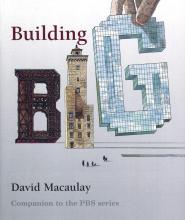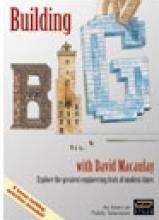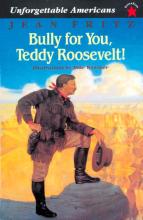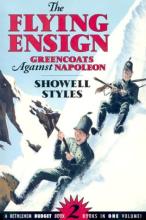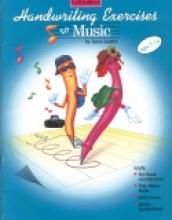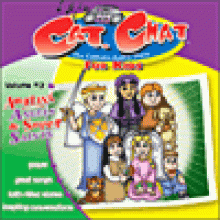No name
Building Big
Originally written as a companion to the PBS series of the same name, Building Big stands on its own quite well — a good thing, because the videos are no longer in production.
If you are familiar with David Macaulay's other books, such as Castle and Cathedral, also reviewed here, Building Big has a similar visual appeal with drawings that delve into the details of the structures in a way that is both fun and informative. I would especially recommend this book to kids (and adults!) ages 10 and up who enjoy building toys such as Legos, K'nex, or wood blocks, as well as to those who are interested in historical structures or how things are made. Younger children who have similar interests will also enjoy the pictures, especially if a parent summarizes the text for them.
The book covers BIG Civil Engineering structures ranging in construction date from ancient Rome through the 20th century. There are sections covering bridges, tunnels, dams, domes, and skyscrapers, with four to ten chapters in each section, each covering the design and construction of an outstanding example of that type of structure. The examples are chronologically sequenced and show important steps in the history of the development of techniques and technology.
The combination of text and illustrations does an admirable job of making learning about building on a large scale enjoyable. Many excellent drawings and diagrams explain how particular structures were built, showing relevant details and the techniques used. They also explore why certain materials and designs were chosen as solutions to the problems specific to the desired function, siting, and other constraints.
Along with hands-on construction toys, books like this one can help kids develop a gut feel for forces, loads, and so forth, which are very important to future work in engineering or construction (even small scale construction like home improvement projects). Dh and I are both engineers, as are two of our sons. We have been surprised that many engineering students today lack that intuitive sense — possibly a consequence of more "virtual" play and less physical play — and would love to see that trend reversed.
Building Big with David Macaulay
This set of five DVDs by artist/architect David Macaulay provides many hours of insightful entertainment and a great introduction to science and technology on a practical level. Each themed film - Bridges, Skyscrapers, Tunnels, Domes and Dams - provides an in-depth historical treatment of the particular structure, interesting stories and overviews from famous structures, and basic scientific principles involved in each project.
The set features lots of great location shoots with David Macaulay narrating interesting stories and pointing out details of each site.
To give you an idea, "Tunnels" covers aqueducts and water-carrying tunnels of Ancient Rome, early canal and train tunnels of the 19th century (particularly in England and the U.S.), archaic and modern methods of tunnel digging (particularly under rivers), issues involving tunnel safety (both during the project and during use afterwards) with a special emphasis (in all areas) on the building of the Channel Tunnel in the 1990s between England and France. Each video also includes a "Building Small" segment and pamphlet so that families can tackle simple science projects at home that demonstrate principles of architecture.
Our family has really enjoyed these movies - from the four year old all the way up to Mom and Dad. The material is substantial, but easy to understand (particularly with the excellent use of computer graphics and artistic sketches).
I would recommend parental supervision with young children, at least for the first viewing. There are a few things that might be scary for little ones, such as a spooky introduction to the Tunnel show and some photos from an airplane crash in to the Empire State Building that might be a little disturbing. There are also some points in other movies that would be worthy of discussion, such as the environmental issues that come up in the Dams movie. Those are all the "sticky" parts I can remember at this point. I am hoping to view them again soon and will add to this list as needed. Overall, I consider the series to be very worthwhile and enjoyable.
Set of 5 DVDs or Videos (approximately 1 hour each)
Update April 2024: These videos are now "out of print" and difficult to purchase. However, I'm planning to review the book of the same title. Stay tuned. :)
Building on Nature
Like most art students and lovers, I have had mixed feelings about the architecture of Gaudi all my life. When our oldes son visited Barcelona and sent pictures of Gaudi buildings, I planned on learning more about him. Now I find this new and remarkable picture book telling children about a man who was perhaps little understood during his lifetime.
What I find in the warmly-illustrated pages is a likeable man! A devout Catholic, a lover of nature and of poverty, married to his life's hard work. Perhaps his art isn't traditional, in any shape or form, but there is a genuine aspect of Gaudi's work that one can't help being attracted to.
This picture book does a good job of bringing his life and work to young children and it is a fun read aloud, written in the present tense, in poetic lines. The author's note adds important biographical information including the fact that he was a very early recycler, using all sort of discarded materials in his buildings. A list of websites is also listed. I found this list of buildings with photos very useful!
Building the Family Cookbook
The book then follows the Liturgical Year's feast days with Saint's feast day or other feasts and includes a short biography of the saint or a description of the feast day along with a recipe for the day. Because the book follows the Liturgical Year, there is not a recipe for every single day.
The recipes vary. One day will be a main dish. The next day is a dessert. Surprisingly, the recipes are not the typical "diet" variety. In other words, the "St. Therese Fudge Brownies" have real butter and don't skimp on sugar. That is because The Light Weigh program allows the person to eat any type of food, just limited to small quantities. You do not need to be familiar with The Light Weigh program to enjoy the recipes or benefit from the wisdom of the book. But if you would like more information about The Light Weigh program, you can contact Suzanne at the webpage listed below.
The book closes with more advice on building a happy family, sources for the feast day information and an index to the recipes. Following her practical advice, sharing these wonderful saint stories, and enjoying these delicious recipes is a sure way to achieve Suzanne's goal of making dinner time your family's favorite time.
Bully for You, Teddy Roosevelt
This is an interesting biography of one of our nation's most colorful presidents. It was interesting to discover that Teddy Roosevelt (1858-1919) was a rather sickly youth who suffered from asthma. His determination in overcoming his illness and living a full life despite his rather frail body help to make him a man who loved life and tried to live his life to the fullest – especially enjoying the world around him. He was a nature enthusiast and an avid hunter and is considered one of the pioneers of the conservation movement – although certainly not what some today might call a "wacko environmentalist." This aspect of the story might lead to some interesting discussions with your children about a proper stewardship of nature. It is interesting to note how he was affected by the harsh winter of 1886-1887 which devastated the Dakotas where Roosevelt had a huge ranch. I believe this was the same year described in the book The Long Winter by Laura Ingalls Wilder. A comparison of the two perspectives might make an interesting writing assignment. I can't comment on the accuracy of the author's presentation of the politics of the day – especially the war in Cuba – as I haven't read much else about it. This book would provide interesting reading and discussion material for approximately grades 5-8.
By What Authority
It is early in the reign of Queen Elizabeth. Religion and politics are curiously mixed and confused. How will the people of England survive this tumultuous time and emerge as one of the great powers on the earth. This is the setting for By What Authority by Monsignor Robert Hugh Benson. It is the story of how two families, one Catholic and one Protestant, sort through the confusion and endure the suffering of finding and maintaining a religious identity.
The head of the Catholic family, Sir Nicholas Maxwell, is the Lord of a section in England just south of London. The Protestant family, Norris, lives next door and has a good rapport with the old Catholic family. The primarily Protestant village has great love for the Lord and his family and forgive them their superstitious religion. It is obvious that the younger Maxwell son is in love with Isabel Norris but the differences in their religions keep them apart – for a time.
Isabel Norris is a Jane Austen -type character, full of virtue and feminine moderation. She is happily Protestant and deeply devoted to her beloved Jesus. Her father, sensing the Maxwell youth's love for her, and worried lest the Maxwell ladies should convert her daughter to Catholicism, sends her to a friend in the country who is STRICTLY Puritan. His hope is that she will be repelled by the strictness and return to his middle-of-the-road Church of England Protestantism. Isabel is indeed horrified at the fiery God portrayed in the Puritan church but the movements of her heart and religious sentiments foreshadow her as a Catholic at heart. While she is away her father dies and when she returns, Lady Maxwell's sister becomes her living companion. This sister is actually a nun who was sent away from her convent and so begins the slow conversion of Isabel. Msgr. Benson is masterful at describing the mental and spiritual movements of a soul and so the reader is brought through all the agitation and wonder of Isabel discovering, discarding and finally accepting the truth about the Catholic Faith. In the midst of her struggles, young Hubert Maxwell has stated his intentions toward her and begs her to wait for him, claiming that the religious issue will resolve itself somehow. He leaves to sail off with Sir Francis Drake on one of his first piratical voyages. When he returns, ready to embrace her AND proud to announce his conversion to her Protestant faith, he finds that she has very nearly converted to Catholicism. He is furious and offers to be whatever religion she wants. In saying that, he has lost her. To her, the Faith is something so intrinsic that it cannot merely be put on and off as is convenient. She maintains her love for him through the whole story but she knows that she cannot be his wife.
All the while Isabel is suffering and coming into the Catholic Faith, her brother Anthony has graduated from Cambridge and, full of patriotism and religious fervor, sets out to set himself up in the world. He goes to work for the Archbishop of Canterbury and so is thrust into the politics and religion of the times. He has an occasion to meet and debate with a Catholic man and feels his Protestant beliefs disturbed. He also witnesses Edmund Campion's so-called trial and his execution and is very much affected by it. Msgr. Benson spends a lot of time describing the trial and relating the arguments made on both sides. During this trial, Anthony is basically converted. He sees that ALL the religious questions boil down to who has the authority to interpret the Bible and speak for Christ. Protestantism taken to its extreme would have each person interpreting the Bible as he would and becoming his own authority. That in itself did not fit with scripture, he thought. He realizes that the Church of Rome has the greatest claim to that authority. He submits his resignation to the Archbishop and attends an Ignatian Retreat with Father Robert Persons. At the end of the retreat he goes to tell his sister, Isabel that he has converted only to find her in the same situation. They come into the Church together to the great joy of the Maxwells (excepting Hubert).
Anthony becomes a priest at a seminary on the Continent and returns with Isabel to England at the time of the defeat of the Spanish Armada. He eventually is captured and threatened with torture and death. He meets with the Queen herself and she offers to let him leave the country alive yet have it let out that he signed "the oath" which says that he acknowledges the Church of England. He, of course, refuses and the enraged Queen sends him off to the torturers. He dies on Easter morning as Isabel kneels at his bedside reading the Gospel of the day. She has decided to leave England and perhaps enter religious life.
One of the most interesting aspects of the story is Benson's portrayal of Queen Elizabeth. She is fierce and unforgiving yet feminine and remorseful. He is very successful at describing the development of the awe in which her subjects hold her. She is awe inspiring. She is a formidable enemy and very moved by the loyalty of her people. She admires the gallantry and strength of the Catholic martyrs. She does not seem to be a deeply religious person herself and so cannot understand why these Catholics can't just accept things in order to live and have peace. He portrays her as having a certain goodness that is overshadowed by a multitude of forces, both within her and without.
The story would be excellent for upper high school level (and any interested adult). It might be interesting to read it along with a biography of St. Edmund Campion or Sir Francis Drake, and some history of the Spanish Armada. It is a compelling period in history and bears some deep thought as to its effect on today's world.
Byrd of the 95th
This book is now included in the Bethlehem Budget Book The Flying Ensign, also reviewed on this site.
I really liked this book. I can vouch for my wife's statement that this is a great read aloud. I read it to my children at bedtime (ages 3 through 9) – they were engaged... though the younger ones usually fell asleep. The older two LOVED it.
Like the first book, there are plentiful descriptions of landscape, escapes, rescues, heroes, villains and architecture. The latter two are grouped for a reason. This book finds the ensign and all the principle characters of the last book together again. This time however, the story centers around a diversion to rescue the beautiful Anita and her noble father Don Claudio del Riego (one of the wealthiest noblemen in French-occupied Spain). They have been kidnapped, along with their hidden cache of jewels, by the traitorous El Cuchillo – a brigand from an ancient and once respected family – who makes his home in the family castle in the mountains. The castle features a knife-like spike of rock projecting up from within the fortress.
That the Spanish nobleman is now allied with the occupying French force, or that he chose to be a brigand rather than a noble may each be subjects for discussion of how the author gave him his nickname and abode – El Cuchillo – The Knife.
I had a hard time unraveling some of the battle scenes the author describes in the story until I got to the very helpful map on pg. 277. There's a lot of interesting military history, but I would have appreciated a few more maps.
It should also be noted that the author, while painting the valor and honor which the young ensign felt and aspired to, does not refrain from describing some of the gruesome aspects of battle. Unlike so many Disney stories (thank goodness) men actually die in this book. Children are neither idiots nor prudes in realizing the effect of violence can be death! You may want to read it to your kids – you can. But, for younger listeners, you may wish to keep an eye out for the few graphic descriptions. For instance: "In the ranks a few yards away gaps appeared – men flung into fragments by the flying [cannon] balls, men struck down and screaming in agony." Or in the story above: "... saw one twelve-pounder ball hurtle through the ranks a few paces from him, tearing two green-coated men into red fragments and ripping an arm from a third."
This is an enjoyable, readable story about a heroic young man who braves dangers and wins. In other words, a good hero story for kids. And the pretty young sable-haired Anita should be appealing to both boys and girls as a person who knows courage as well as courtliness.
This book was donated for review by Bethlehem Books.
Callirobics
Callirobics will significantly and quickly improve your child's penmanship, even though he'll never form a single letter while using it. If your child has difficulty with consistency in formation, slant, and spacing, thinks he "just can't do it", has a bad attitude toward penmanship, or simply benefits from auditory and kinesthetic modes of learning, this may help.
The name, "Callirobics", refers to calligraphy and aerobics; these are exercises (though not very oxygen intensive, thankfully!) for the hand and brain, set to music. The program is an adjunct to any manuscript or cursive program that you are using, not a replacement for it. Its goals are to improve "eye-hand coordination, fine motors skills, self-esteem, and handwriting". Don't let the inclusion of self-esteem put you off; this program delivers what it promises, and the self-esteem is a natural result of accomplishment.
Callirobics was recommended by St. Thomas Aquinas Academy for my 6th grade daughter, but I decided to use it for my 8th grade daughter and myself as well. Within the first month of using the program for about 10 minutes a day, as instructed, I could see significant improvement. The endings of words started tending up instead of down; letters were better formed and more evenly spaced; there was a great improvement in slant and smoothness. Callirobics is rapidly and almost effortlessly effective.
A nice fringe benefit was that we began associating penmanship with joyfulness, since the combination of Liora's appealing accent (she introduces each exercise) and the engaging instrumental music create a pleasant mood. The children enjoy it so much that they ask to do Callirobics every day.
As effective as it is, Callirobics might not appeal to you initially if you're accustomed to more serious, formal approaches to schoolwork. The program has light-hearted illustrations and exercise titles ("Curly Head", "Lucky Clovers"). Also, the affirmations for students to write after each exercise may strike you as too full of phony self-esteem or humanist sentiments ("I make my life safe and happy", or "I am a beautiful person"), though some are not so bad ("I focus my attention on the task at hand"). The fix for that is to have your children write other sentences, such as "I'm thankful for the gifts God gives me", or to skip the affirmations altogether. The program will work just fine without them.
There are five levels: Beginning, Ages 4 - 7, 7 - 14, Advanced, and Adult, with different patterns and music for each. We are using the program for Ages 7 - 14, geared to cursive writing. The teacher's manual states that you need a Callirobics notepad; however, I called the 800 number and was told by Liora, who answered the phone, that any paper the student would normally use is appropriate.
For all those whose penmanship needs some shaping up, Callirobics may be just the right exercise program.
Set includes book plus CD or audio tape
Non-consumable
Cat. Chat: The Catholic Audio Show For Kids Vol. 3
Vol. 3: Amazing Angels and Super Saints It's time to have a party! A saints and angels party. In this volume, the family - Papa, Josh, and Hannah - hosts an All Saints' Party for the kids and their friends. The format is the same as the other two volumes. Moses, the family cat, introduces the audio show with commentary in the middle and at the end, the family has discussions about the faith to lead the children to a greater understanding of the Catholic truths of the faith, the dialogue is interspersed with lively, contemporary songs, and the evening's entertainment closes with a prayer. To spice up the program with a little variety, a new character, Rocko - "the coolest dog in town" (who likes to banter with Moses) - joins the cast.
Just as in a real Saints' Day party, the children take turns on stage, dressed in costume, giving presentations of various saints and angels, including St. Michael, St. Therese, a Guardian angel, St. Dominic Savio, St. Francis of Assisi, and St. Elizabeth Ann Seton. Dressed as St. Joseph, Papa also gives a presentation. With all new foot-tapping songs your children will love to sing, sound effects with pizzazz, and interesting stories to encourage them to live more like Jesus, this CD is sure to be a hit.

